#joe mauldin
Text

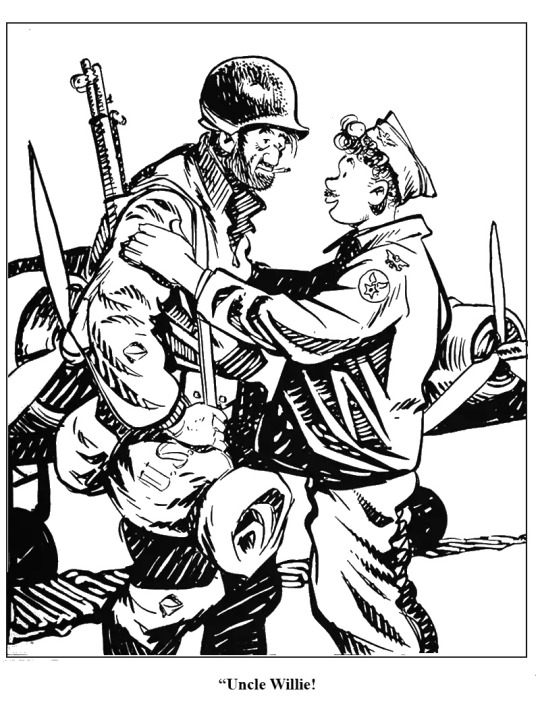


Cartoonist Bill Mauldin, whose characters Willie and Joe captured the unheroic nature of the G.I.'s life in WWII while portraying the G.I.s’ truly heroic nature.
212 notes
·
View notes
Text
The Crickets - Not Fade Away (1957)
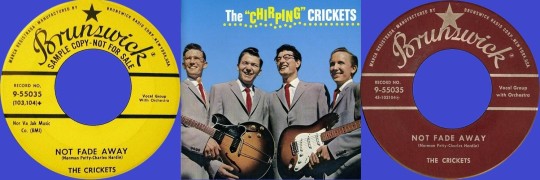
The Crickets - Not Fade Away (1957)
Charles Hardin Holley (Buddy Holly) / Norman Petty
from:
“Oh, Boy!” / “Not Fade Away” (Single)
“The "Chirping” Crickets“ (LP)
1st Wave Rock and Roll | Rockabilly
JukeHostUK
(left click = play)
(320kbps)
~or~
SnuhFiles
(left click = play)
(320kbps)
Personnel:
Buddy Holly: Lead Vocals / Lead Guitar / Rhythm Guitar
Niki Sullivan: Backing Vocals
Joe B. Mauldin: Double Bass
Jerry Allison: Drums / Backing Vocals
Produced by Norman Petty
Recorded:
@ The Norman Petty Studios
in Clovis, New Mexico USA
on May 27, 1957
Single Released:
on October 27, 1957
Album Released:
on November 27, 1957
Brunswick Records
♪♪♪ ♪♪♪ ♪♪♪
In 2004, 'Not Fade Away' was ranked #107 on Rolling Stone's list of "The 500 Greatest Songs of All Time"
In 2012, 'The "Chirping” Crickets' was ranked #420 on Rolling Stone's list of "The 500 Greatest Albums of All Time"
♪♪♪ ♪♪♪ ♪♪♪
#Not Fade Away#The Crickets#Buddy Holly#Norman Petty#The "Chirping” Crickets#Rock and Roll#1st Wave Rock and Roll#Rockabilly#1950's#Brunswick Records#Jerry Allison#Joe B. Mauldin#Niki Sullivan
27 notes
·
View notes
Text

Buddy Holly - Rave On (!958)
Sonny West / Bill Tilghman / Norman Petty
from: "Rave On" / "Take Your Time" (Single)
Rock 'n' Roll | Rockabilly | 1st Wave Rock and Roll
"Buddy Holly is instantly recognizable as the artist:
The record begins with a drawn-out "𝘞𝘦𝘭𝘭…" as stylized by Holly's distinctive hiccup ("𝘈-𝘸𝘦𝘩-𝘶𝘩-𝘩𝘦𝘩-𝘶𝘩-𝘦𝘭𝘭…")."
- Wikipedia
JukeHostUK
(left click = play)
(320kbps)
Personnel:
Buddy Holly: Vocals / Guitar
Niki Sullivan: Rhythm Guitar
Joe B. Mauldin: Bass
Jerry Allison: Drums
Norman Petty: Piano
Al Caiola: Guitar
Donald Arnone: Guitar
Backing Vocals:
William Marihe
Robert Bollinger
Robert Harter
Merrill Ostrus
Abby Hoffer
Produced by Milton DeLugg
Recorded:
@ The Bell Sound Studios
in New York City, New York USA
on January 25, 1958
Released:
on April 20, 1958
Coral Records
#Rave On#Buddy Holly#Sonny West#1950's#Milton DeLugg#Norman Petty#Rockabilly#Bill Tilghman#Coral Records#Jerry Allison#Joe B. Mauldin#Rock 'n' Roll
9 notes
·
View notes
Text



The crickets
Been learning more abt Buddy and his freinds so thought I’d draw the OG cricks.
I think Jerry Allison came out the best. I like the way I stylized him. Especially in the eyes. His overall expression. I think it’s just a good reference pic.
There’s like 0 pics of Niki. 0. None. Well, no good/high res/good for ref pics. It was hard to find for Joe too. Maybe Jerry is just a fan fav.
#niki Sullivan#Joe B Mauldin#Jerry Allison#the crickets#buddy holly#the chirping crickets#music#1950s#1950s music#buddy holly and the crickets
6 notes
·
View notes
Text





What Linus says in the top comic strip is true. Bill Mauldin was the greatest cartoonist of World War II. He created a comic strip—Willie and Joe—that depicted two regular G.I.s (shown in the bottom comic strip), that ran in Stars and Stripes during the war. Its biting and honest humor in depicting life for the common Soldier was a huge hit with the rank-and-file and helped keep Soldiers’ spirits up during some of the conflict’s darkest days.
After the War, Joe and Willie occasionally reappeared, such as to commemorate the deaths of Generals George C. Marshall and Omar N. Bradley. For many years Charles M. Schulz honored Mauldin in his Veteran’s Day comic strip. Joe and Willie’s last appearance occurred in the Peanuts comic strip shown above.
Happy Veteran’s Day!
35 notes
·
View notes
Text

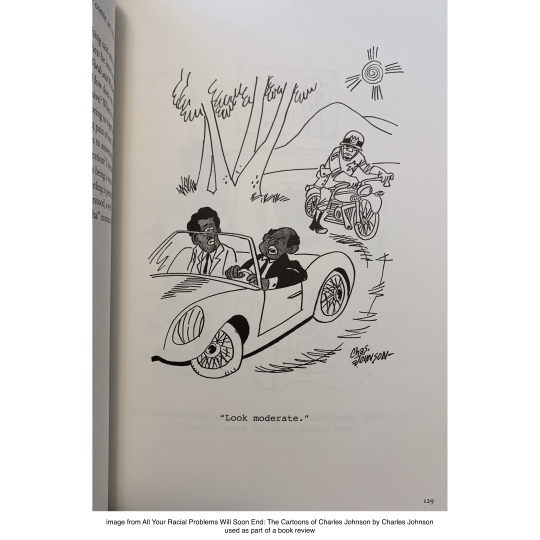


All Your Racial Problems Will Soon End: The Cartoons of Charles Johnson by Charles Johnson. New York Review Comics, 2022. 9781681376738. 280pp. https://www.powells.com/book/-9781681376738?partnerid=34778&p_bt
I had no idea Dr. Johnson (Middle Passage) was also a cartoonist. I regret that I didn't take one of his writing courses when I studied English at the University of Washington -- something I told Dr. Johnson when I met him years later -- but now that I know he's a talented cartoonist as well I'm smacking myself in the forehead again.
This is a retrospective of Dr. Johnson's cartoons with introductory text to each section, starting with the beginnings of his career, when he published illustrations in a magic company's catalog while still in high school, and ending with comics he's done more recently, many of them Zen-themed. The bulk of the book contains work from the late 1960s and early 1970s, when Dr. Johnson was, as he explains, "…philosophically, a Marxist and a socialist." They're excellent single-panel gags, mostly political, and very much of their time. Many of the best concern the black power movement and responses to it. Reading the bulk of this book reminded me of reading Willie & Joe Come Home by Bill Mauldin, a collection of comics about the struggles of soldiers returning home after WWII, in that both that book and this reflect struggles I should know more about the context of. (In other words, great comics are once again sending me off to read about history I should already know.)
32 notes
·
View notes
Photo

Joe Mauldin, Jerry Allison And Buddy Holly On Their New Motorcycles
Today is the day the music died.
Buddy, Waylon & The Ariel Cyclone
February 3, 1959 — The Day the Music Died.
Buddy Holly, Ritchie Valens, “The Big Bopper” J.P. Richardson, and their pilot, Roger Peterson, die in a plane crash near Clear Lake, Iowa. Holly leaves behind millions of adoring fans, a pregnant wife and a legendary 1958 Ariel Cyclone Motorcycle.
May 13, 1958 - Buddy Holly and his Crickets bandmates, Joe Mauldin and Jerry Allison, land in Dallas after a world tour. They go straight to a Harley-Davidson dealership looking to buy three Harley 74 flatheads. The salesman is skeptical that the three young men from West Texas have the wherewithal to purchase three of his expensive motorcycles, and tells them so. Put off by the rude salesman, the boys go across town to Miller’s Triumph Shop. This time, Buddy introduces himself and produces a large amount of cash to ensure that it is known they are serious buyers. It is probably not necessary because Betty Miller, co-owner of the Shop with her husband, Ray, recognizes Buddy and the Crickets the moment they come in.
Mauldin picks out a red Triumph Thunderbird. Allison goes for a Triumph Trophy TR6A. Buddy buys the new 650cc Ariel Cyclone — one of only 200 ever made.
That summer, between tours and television appearances, Buddy and his friends are often seen riding their motorcycles around town in Lubbock.
October 1958 — Buddy Holly splits from The Crickets.
Early 1959 — Buddy Holly is touring the Midwest with his new band, including bassist Waylon Jennings. Also on the tour are rising artists Ritchie Valens and “The Big Bopper” J.P. Richardson. The going is rough aboard cold, uncomfortable buses and, frustrated by the conditions, Holly charters a plane from a performance in Clear Lake, Iowa to the next stop in Moorhead, Minnesota. Holly bandmate Tommy Allsup and Valens toss a coin for a seat on the plane — Valens wins. Waylon surrenders his seat to Richardson, who is sick.
Buddy Holly & Waylon Jennings February 3, 1959, 12:30 am — Holly, Richardson and Valens take off with Peterson, their 21-year-old pilot. The rest is history. Buddy Holly was 22 years old when he died. Richardson was 28. Valens was 17. Waylon lives on to be one of the most legendary country music artists of all time.
Buddy’s father keeps his Ariel Cyclone until 1970 when he trades it to Nub Stovall, a local racer, for two Yamaha 55cc Trailmasters. Stovall sells the Ariel to another individual, who tries to resell it to a local Honda dealer, George McMahan, for $1000. McMahan wants the bike, but does not have the funds.
Waylon Receiving His Birthday Present 1979 — Former Crickets Mauldin and Allison want to do something special for the 42nd birthday of their old friend, Waylon Jennings. They track down Buddy’s motorcycle to the man who still owns it in Austin, Texas. They buy the bike and have it delivered to an empty hotel room in North Texas where Waylon is on tour. Upon seeing his gift — at midnight — the outlaw Waylon jumps on the bike and kick starts it right there in the hotel room, to the delight of the other guests. Waylon only rides the Ariel a couple times and then lends it to the Johnny Cash Museum in Nashville.
2002 — Waylon Jennings passes away.2014 — The Ariel is auctioned off as part of Waylon’s estate. George McMahon has his second shot at owning the legendary bike. (McMahan had done well as a land developer in Lubbock and now had the means to buy the Ariel.) At auction, the bike quickly is bid up to $475,000 and McMahan bows out, fearing he has missed his chance again.
But fate is with McMahan. The Ariel does not reach the seller’s minimum and does not sell at the auction. Jessi Coulter, Waylon’s widow, is taking offers based on price AND intended use. McMahan makes his offer and specifies his use — riding the bike just one time and then loaning it to he Buddy Holly Center in Lubbock. Done deal.
This is the incredible story of a legendary 1958 Ariel Cyclone, owned by two of the biggest legends in music history. Check it out at the Buddy Holly Center if you’re ever down in Lubbock — but note, no pictures allowed.
18 notes
·
View notes
Text

Voice For Children Signed "Cartoon Jam" Print (Stabur Graphics, 1986)
“This panoramic print features perhaps the largest number of cartoon licenses granted for one project, as well as what might be the most cartoonists participating in one cartoon jam for a commercial print. The scene also features the first licensed appearances of Walt Disney and Walter Lantz characters co-starring in the same piece. It's a veritable ‘orchestra and choir’ of characters singing for the welfare of children as the ‘Voice For Children.’
“Signed by: Stan Lee, Charles Schulz, Walter Lantz, Jim Davis, Johnny Romita, Milton Caniff, Mort Drucker, Jack Kirby, Bill Keane, Mike Royer, Moebius, Sergio Aragones, Hank Ketcham, Kelly Freas, Bob Thaves, Jim Unger, Jack Hannah, Don Dougherty, Jerry Van Amerongen, Leonard Starr, Arnold Roth, Tom Batiuk, Mike Peters, Harvey Kurtzman, Al Jaffee, Morrie Turner, Mel Lazarus, B. K. Taylor, Marty Murphy, Dean Young and Stan Drake, Russell Myers, Jim Meddick, Dick Locher, Mort Walker, MacNelly, Johnny Hart, Fred Lasswell, Paul Coker Jr, Irwin Hasen, Ray Salmon, Dick Browne, Will Elder, Bud Sagendorf, Dick Moores, Joe Martin, Jack Davis, Bob Foster, Judd Hurd, Frank Ridgeway, Al Williamson, Bernard Kliban, Bill Mauldin, and more.
“And featuring these characters: The Amazing Spider-Man, Captain America, Ms Peach, Mama, Wizard of Id, B. C., Nancy and Sluggo, Robotman, U. S. Acres, Gasoline Alley, Dondi, Conrad, Broom-Hilda, Mama, Wee Pals, Luann, Animal Crackers, Terry and the Pirates, Wright Angles, Dick Tracy, Family Circus, Benchley, the Neighborhood, Charlie Brown, Peanuts and Snoopy, Beetle Bailey, Hi and Lois, Hagar the Horrible, Groo the Wanderer, Cathy, Mickey Mouse and Donald Duck, Popeye, Blondie, Woody Woodpecker, Little Annie Fannie, Mr. Abernathy, Little Orphan Annie, Dennis the Menace, Herman, President Ronald Reagan, First Lady Nancy Reagan, Buddy Hackett, Snuffy Smith, Garfield, and Alfred E Neuman.”
Source
5 notes
·
View notes
Text
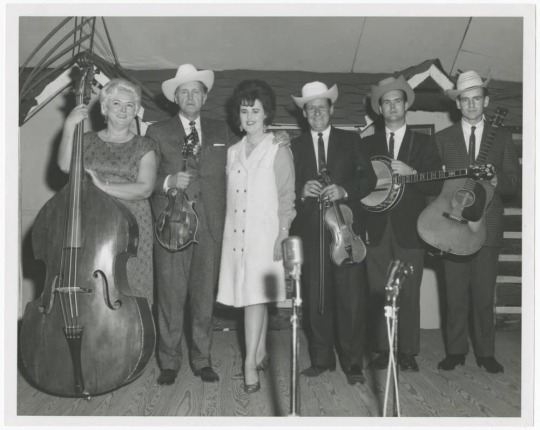
Bessie Lee Mauldin, Bill Monroe, Melissa Monroe, Joe Stuart, Bill Keith & Del McCoury
12 notes
·
View notes
Text
Why did Isaac Asimov not like Robert Heinlein? Didn't Asimov know how kind Heinlein was to writers that he didn't agree with?
COMMENTARY:
I don’t agree that Heinlein was a libertarian, as Matt Riggsby · asserts. Heinlein was a Naval Academy graduate and his thinking was uniformly Hegelian in aspect,. I don’t even agree that he was militaristic.
During the 60;s (and continuing today0 there are left wing libertarians, such as the anti-war Liberals, and right-wing libertarians, such as the pro-war Conservatives, such as William F. Buckley and the Ivy League Socialism of the John Birch Society. And Ayn Rand. Both the 60s Liberals and Conseervatives employed a version of reasoning characterized by Ayn Rand’s Virtue of Selfishness. which uses half of the Hegelian gestalt to justify their ideological perspective on the battle in Vietnam.
In this regards, it would be useful to review James Carse’s Finite and Infinite Games. Hegel represents the Infinite Game,while both the Liberal and Conservative arguments regarding Vietnam represent Finte Games ·constructed to win the argument, Rand’s Virtue of Selfishness is a Finite Game in which she advocates a dishonest argument. William F. Buckley conducted a seminar in Fascist sophistry with his Firing Line program (which Mollie Hemingway has resurrected) which he taught right-wing college students how to win academic arguments in support of his Nazification agenda. Maga Mide Johnson, Speaker of the House, is a study in a profound dedication to the Finite sophistry of both his politics and Total Depravity Gospel theology: in his case, his willingness to define the essence of his oath of office, Romans 13:1 - 7, as a foundation for treason, illustrates the nature of the Conservative movement as a Fintee game.
Heinlein neve deconstructs the Hegelian Historic Gestalt to make a point. His Starship Troopers criticized by left0wing libertarians for being a Fascist manifesto, when, in fact, it was an adventure story set in the sociology of Plato’s Republic as typical of his somewhat pedantic inclination to educate what had been a young adult market. His decryption of the necessarily authoritarian military culture was accurate of the American citizen soldier tradition that Ernie Pyle and Bill Mauldin describe, The fact is that he had followed the Army R&D programs from the lessons learned from WWII and the Starship Troopers were based on the product of the Army Ranger School. His advice to young officers in regards to their relationship with senior NCOs is sage.
The fact is, the Army combat veterans of Vietnam were the first generation of Starship Troopers and the 101st Air Mobile “Screaming Eagles: Division became the Army’s test bed for the Mobile Infantry doctrine reflected in the very accurate small unit battle drill of the movie Aliens.
If you want to know what if felt like to be on the Ho Chi Minh Trail and running for your life to a hole in the triple canopy for extraction, Aliens captures the dynamics. And Heinlein’s canon never strays from that essential Hegelian aspect.
Just for the record, Joe Haldeman’s “Forever War” is the squeal to Starship Troopers, written by a Vietnam Starship Trooper. And his narrative is Hegelian in aspect. Neither he nor Heinlein were “Conservatives” in the Maga Mike Johnson sense of the word.
Isaac Asimov was an anti-war version of Ayn Rand’s libertarianism, Robert Heinlein was consistently Hegelian in aspect,
0 notes
Audio

Buddy Holly - Peggy Sue (1957)
Jerry Allison / Norman Petty
from: "Peggy Sue" / "Everyday"
Rock and Roll | Rockabilly
JukeHostUK
(left click = play)
(320kbps)
Personnel:
Buddy Holly: Vocals / Guitar
Joe B. Mauldin: Acoustic Bass
Jerry Allison: Drums
Produced by Norman Petty
Recorded:
@ The Norman Petty Recording Studios
in Clovis, New Mexico USA
on June, 29 and July 1, 1957
Released:
on September 20, 1957
Coral Records
"Jerry Allison had a prominent role in the production of the song, playing paradiddles on the drums throughout the song,
the drums' sound rhythmically fading in and out as a result of real-time engineering techniques by the producer, Norman Petty."
- Wikipedia
+++ +++ +++

( https://imgbox.com/GiNfigSA )
Jerry Allison
August 31, 1939 – August 22, 2022
American Musician | Drummer |
Buddy Holly | The Crickets
Jerry Allison, Who Played Drums With Buddy Holly, Dies at 82 - NYT
An original Cricket, he was also a co-writer of two signature Holly songs, “That’ll Be the Day” and “Peggy Sue.”
Jerry Allison, Drummer and Songwriter for Buddy Holly and the Crickets, Dead at 82 - RollingStone
Rock and roll pioneer helped pen some of Holly's classics, including "Peggy Sue" and “That’ll Be the Day”
Jerry Allison, last original member of Buddy Holly's Crickets, dies - Texas Public Radio
Jerry Allison - Wikipedia
#Jerry Allison#The Crickets#Buddy Holly#Peggy Sue#Obituary#Rockabilly#Norman Petty#Coral Records#1950's#Joe B. Mauldin#Rock and Roll
28 notes
·
View notes
Text
. He said, as he announced my appointment, “Keep us strong,
keep us ready, so that we may keep the peace.” The essence of our strategy is
keeping the peace by keeping strong and ready. The United States is not
charging around looking for war. No one who has ever experienced war could
ever want another one. I am reminded of that great cartoon by Bill Mauldin
from World War II. It shows “Willie and Joe” all dirty and scruffy and tired,
sitting on the bombed-out steps of what was once a house. A clean, confidentlooking soldier swaggers by and Willie turns to Joe and says, “That can’t be no
real combat soldier, Joe. He’s actually out lookin’ fer a fight.”
We face a difficult and uncertain world. But, we can face that world with
confidence. We have just finished a national election, an important
demonstration that the pronoun for the United States is “We.” Sometimes,
when I listen to people talk, I believe they think that it’s “they”: “They did it.”
“They are responsible”—that ubiquitous “they” without any antecedent to the
pronoun. But, in fact, America’s pronoun is “we.” “We hold these truths to be
self-evident that all men are created equal.” “We, the People of the United
States, in order to form a more perfect Union, establish justice, insure domestic
Tranquility, provide for the common defence.” “We pledge our lives, our
fortunes and our sacred honor”—Whatever this country does or fails to do, “we”
will do it, “we” the people. “We” are responsible for it.
There aren’t any cheap, easy gimmicks as we seek world peace and
national security. Strength, steadiness, hewing
0 notes
Text
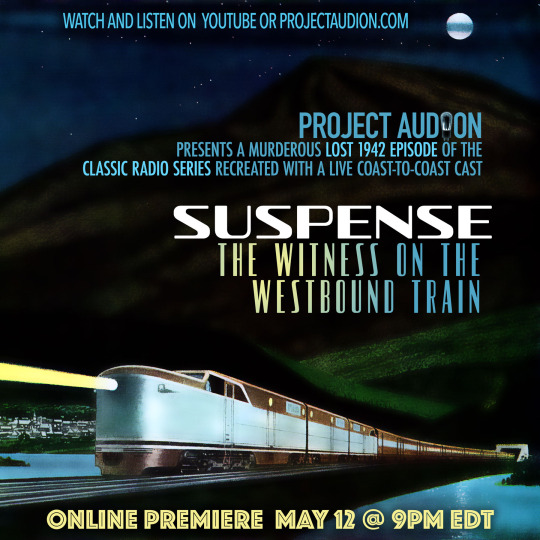
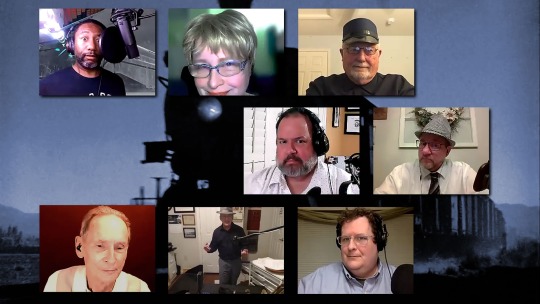
This drops tonight, 5/12/23!! The cast as follows:
MARK: Pete Lutz, TX
JOE: Doug Fain, KY
DORIS: Patte Rosebank, Canada
CONDUCTOR: Denny Thmpson, CO
LAWRENCE / RANDOLPH: John Mauldin, TN
BILL / BAGGAGEMAN: Dick Huitema, FL
ANNOUNCER / WAITER: Robert Stevenson, IN
DIRECTION / PRODUCTION / SOUND: Larry Groebe, TX
Tune in for the YouTube premiere on Friday at 9 PM Eastern / 8 Central / 7 Mountain / 6 Pacific -- or on YouTube or Project Audion's website any time thereafter. And please "like" it and let others know about it!
*
0 notes
Photo

Leading off for today, we'd like to offer Charles M. Schulz a very Happy 100th Birthday! He was born on (We) November 26th, 1922 in Minneapolis, Minnesota. Long before we ever knew him as the creator of Charlie Brown, Snoopy, and the rest of the Peanuts gang, however, Charles did what 14 million other Americans did in the early 1940s: he entered the service, and was assigned to the US Army's 20th Armored Division. Arriving in Europe in February, 1945, and the front lines in April, there was still enough fighting going around for Schulz to be awarded a Combat Infantryman's Badge. With the war ended, he returned home to Minnesota, where he worked on a variety of small graphic arts and illustration jobs. Within five years, the first "Peanuts" strip was published in 1950 - and the rest, as they say, is history. Charles never forgot his Army service, and many of the Peanuts strips paid homage to World War 2's key events, and Schulz maintained a humbled reverence to Bill Mauldin, arguably our nation's greatest combat artist, and the creator of "Willie and Joe." And of course, let's not forget that Snoopy is a famous World War One Flying Ace, who has personally tangled with the Red Baron. Charles Schulz passed away on Feb.12th, 2007, aged 77, leaving a timeless legacy behind him. 🇺🇲🇺🇲 ** Please Like & Follow "Sandy Hook History" on Facebook & Instagram for more amazing maritime and military histories of the Garden State and New York Harbor as well as a review of the 80th Anniversary of the Battle Of The Atlantic and World War 2** 🇺🇲🇺🇲 Photos: All PubDom #visitmonmouth #newjerseybuzz #thejournalnj #locallivingnj #journeythroughjersey #onlyinnewjersey #njspots #centraljerseyexists #discovernj #yesnj #newjerseyhistory #newjerseyforyou #sandyhookbeach #sandyhooknj #sandyhookhistory #forthancockhistory #forthancock #charlesmschulz #charlesschulz #charliebrown #peanuts #snoopy #famousveterans #usarmyhistory #armyhistory #billmauldin #willieandjoe #thefunnypages #redbarron #sundaycomics (at Fort Hancock, New Jersey) https://www.instagram.com/p/ClbkD3hg1c4/?igshid=NGJjMDIxMWI=
#visitmonmouth#newjerseybuzz#thejournalnj#locallivingnj#journeythroughjersey#onlyinnewjersey#njspots#centraljerseyexists#discovernj#yesnj#newjerseyhistory#newjerseyforyou#sandyhookbeach#sandyhooknj#sandyhookhistory#forthancockhistory#forthancock#charlesmschulz#charlesschulz#charliebrown#peanuts#snoopy#famousveterans#usarmyhistory#armyhistory#billmauldin#willieandjoe#thefunnypages#redbarron#sundaycomics
1 note
·
View note
Text
Shine song buddy

When the latter decided he did not want to tour, Petty suggested that Holly hire Sonny Curtis as a replacement. The original two guitarists were Holly and rhythm guitarist Niki Sullivan. Unlike most in that era, he wrote, recorded and produced his own material - and he was among the first musicians inducted into the Rock and Roll Hall of Fame in 1986. He is regarded as the artist who defined the traditional band lineup for rock ‘n’ roll: two guitars, bass and drums. He didn’t want to go, but he had to make some money.”ĭespite his comparatively short career, Holly influenced the music industry. Jennings told Rolling Stone magazine in 1973, “The only reason Buddy went on that tour was because he was broke. As Allison and Mauldin were unavailable, Holly hired drummer Carl Bunch, guitarist Allsup and bass player Jennings as his backing band. With Holly having received no royalty payments from producer Petty, Holly joined the Winter Dance Party because he needed a paycheck. Allison and Mauldin, joined by Sonny Curtis, were working as the Crickets at Norman Petty’s recording studio in Clovis, N.M. 15, 1958 - settled in New York City, Holly was using his own name. While Holly and his newlywed wife, Maria Elena - married on Aug. Holly had temporarily separated from the original Crickets: best friend Jerry “J.I.” Allison on drums, and standup bassist Joe B. 3, 1959, became known as “the day the music died.” It wasn’t until Don McLean released “American Pie” in 1972 that Feb. Holly’s drummer, Carl Bunch, was left behind in Wisconsin, hospitalized for frostbite experienced on the freezing bus. Tommy Allsup lost a coin flip with Valens for the remaining seat. Waylon Jennings gave his seat to the Big Bopper, who had the flu. Holly’s two remaining band members did not board the plane. The destination for the plane, a Beechcraft Bonanza, was Fargo, N.D., the nearest airport to Moorhead. Unable to arrive at Clear Lake’s Surf Ballroom until 6 p.m., Holly decided to charter a plane for his band rather than ride the same bus 500 more miles the next day for a concert in Moorhead, Minn. 2, 1959, 350 miles away, in Clear Lake, Iowa. It was a school bus and we slept on the luggage racks, and it (the bus) kept breaking down.”Īmong those traveling on the bus: Holly and his three-piece tour band, and also Valens, The Big Bopper and Dion & The Belmonts. With temperatures consistently dipping below zero, the heating system in the bus did not work.ĭion DiMucci, leader of Dion & The Belmonts, was quoted in /stories: “It was a rough winter, and we didn’t have those beautiful luxury touring buses. Riding in the bus between concert sites was considered torture. Shows were very well supported, but travel conditions were miserable. The 1959 tour was called the Winter Dance Party. Witcher, recently promoted to assistant city manager, had been managing director of the Buddy Holly Center and other cultural facilities.īober added she felt a need to take over the Saturday tour of Holly landmarks after the 2011 death of Holly historian Bill Griggs. 3 fell on a Super Bowl Sunday, there was a sum total of 10 people at the Buddy Holly Center, and five of them were staff.” On July 1 Columbia issued his self-titled debut album with superstar Clint Black in the producer's chair.“Brooke (Witcher) told me the last time that Feb. By May 5 the "Help Pour Out the Rain (Lacey's Song)" single was delivered to radio and on May 17 he was performing at the Grand Old Opry. On May 3 of that year, Jewell became the winner on country's answer to American Idol, Nashville Star. In 1998 he appeared on Bill Engvall's "I'm a Cowboy" single and in 2002 he sang backup on Ray Price's album Time. By 1995 he started a job as a demo singer and recorded over 4,000 songs by writers who hoped to have their material cut by Nashville's greatest (some of the songs ended up being recorded by George Strait, Trace Adkins, and others). Four years of touring with the unsigned band was enough and Jewell moved to Dallas, TX, to star in a gunfight show at the Six Flags theme park.Įntering a singing contest sponsored by the group Alabama landed him an opening slot for the band and enough inspiration to move to country music's capitol, Nashville, in 1993. By age 21 he decided he wanted to be a singer and headed to Camden, AR, to join the band White Oak. Years later he bought a guitar for ten dollars from a schoolmate and purchased some instructional books with the money he earned bagging groceries. A native of Arkansas, Jewell's earliest musical memories are staring into his parents' radio looking for the "little people" that he thought were living inside. Country singer Buddy Jewell's meteoric rise caused him to be tagged an "overnight sensation," but looking back at his ten years in Nashville obscurity, Jewell considers himself a modern-day Rip Van Winkle.

0 notes